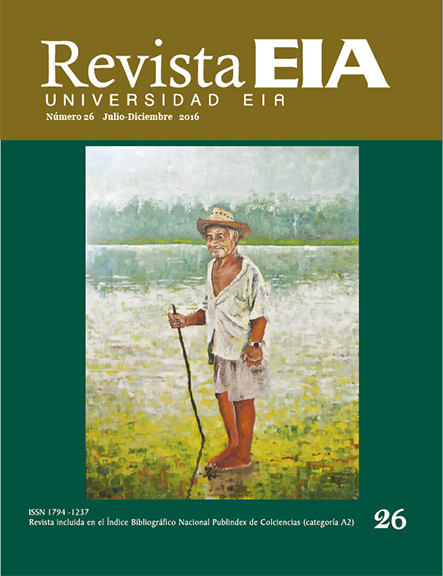ESTUDIO DE LA TOXICIDAD ASOCIADA AL VERTIMIENTO DE AGUAS RESIDUALES CON PRESENCIA DE COLORANTES Y PIGMENTOS EN EL AREA METROPOLITANA DEL VALLE DE ABURRA
ESTUDIO DE LA TOXICIDAD ASOCIADA AL VERTIMIENTO DE AGUAS RESIDUALES CON PRESENCIA DE COLORANTES Y PIGMENTOS EN EL AREA METROPOLITANA DEL VALLE DE ABURRA

Copyright statement
The authors exclusively assign to the Universidad EIA, with the power to assign to third parties, all the exploitation rights that derive from the works that are accepted for publication in the Revista EIA, as well as in any product derived from it and, in in particular, those of reproduction, distribution, public communication (including interactive making available) and transformation (including adaptation, modification and, where appropriate, translation), for all types of exploitation (by way of example and not limitation : in paper, electronic, online, computer or audiovisual format, as well as in any other format, even for promotional or advertising purposes and / or for the production of derivative products), for a worldwide territorial scope and for the entire duration of the rights provided for in the current published text of the Intellectual Property Law. This assignment will be made by the authors without the right to any type of remuneration or compensation.
Consequently, the author may not publish or disseminate the works that are selected for publication in the Revista EIA, neither totally nor partially, nor authorize their publication to third parties, without the prior express authorization, requested and granted in writing, from the Univeridad EIA.
Show authors biography
Los colorantes y pigmentos están comenzando a ser considerados en el país como compuestos que pueden presentar características toxicológicas más allá de los aspectos estéticos en las aguas residuales. Esta investigación presenta los efectos ecotoxicológicos asociados a la capacidad que poseen las sustancias generadoras de color (colorantes y pigmentos) de inhibir la transmisión de la luz en el medio acuático, además de la toxicidad asociada a la molécula que las constituye. A partir de un diseño experimental se correlacionó el efecto de la concentración, contenido de solidos totales y la longitud de onda de máxima absorción de diferentes colorantes sobre el organismo Selenastrum Capricornutum; los modelos de regresión obtenidos permitieron predecir en un 94 y 99% los efectos anteriormente mencionados. La toxicidad molecular fue evaluada utilizando la prueba de toxicidad de Daphnia magna. Finalmente se estudió la toxicidad de vertimientos de aguas residuales correspondientes a los principales sectores industriales del Área Metropolitana del Valle de Aburrá.
Article visits 1817 | PDF visits 778
Downloads
- Sharma, K. A comparative study on characterization of textile wastewaters (untreated and treated) toxicity by chemical and biological tests. Chemosphere [en línea], Vol 69, 1, pp 48-54, Junio, 2007.
- Rand, G. Fundamentals of Aquatic Toxicology: Effects, Environmental Fate, and Risk Assesment. Segunda edición. Estados unidos, Ed. Taylor & Francis, 1995. pp 3-18.
- Bae, J.; Freeman, H. Aquatic toxicity evaluation of new direct dyes to the Daphnia magna. Dyes and Pigments [en línea]. Vol 73, 1, pp 81-85, Diciembre, 2005.
- Verma, Y. Toxicity assessment of dye containing industrial effluents by acute toxicity test using Daphnia magna. Toxicology and industrial health. [en línea]. Vol 27, 1, pp 41-49, India, 2011.
- Gupta, V. Application of low-cost adsorbents for dye removal- A review. Journal of Environmental Management [en línea]. Vol 90, 8, pp 2313-2342, Junio, 2009.
- Methods for Measuring the Acute Toxicity of Effluents and Receiving Waters to Freshwater and Marine Organisms. United States Environmental Protection Agency, EPA. Quinta edicion. Octubre, 2002.
- Wang, K. Treatment and toxicity evaluation of methylene blue using electrochemical oxidation, fly ash adsorption and combined electrochemical oxidation-fly ash adsorption. Journal of Environmental Management [en línea]. Vol 91, 8, pp 1778-1784, 2010.
- Rosenkranz, H. Similarities in the mechanisms of antibacterial activity (Microtox assay) and toxicity to vertebrates. Food and Agriculture Organization of the United Nations. [en línea] 1993.
- Bafana, A. Azo Dyes: past, present and the future. Nagpur, India, NRC Research Press, 2011. Environmental NRC Research Press. [en línea]. Vol 19, pp 350-370, Septiembre, 2011.
- b] Resolución 0062 de 2007. Bogotá, Colombia. Marzo, 2007.
- Verma, Y. Toxicity Evaluation of Effluents from Dye and Dye Intermediate Producing Industries Using Daphnia Bioassay. Journal of Toxicology [en línea]. Vol 4, 2, 2008.
- Dave, G.; Aspegren, P. Comparative toxicity of leachates from 52 textiles to Daphnia magna. Ecotoxicology and Environmental Safety. [en línea]. Vol 73, 7, pp 1629-1632, 2010.
- Immich, A. Removal of Remazol Blue RR dye from aqueous solutions with Neem leaves and evaluation of their acute toxicity with Daphnia magna. Journal of Hazardous Materials. [en línea]. Vol 164, 2–3, pp 1580-1585. 2009.
- Aruoja, V., Dubourguiera, H. Toxicity of nanoparticles of CuO, ZnO and TiO2 to microalgae Pseudokirchneriella subcapitata. [en línea]. Vol 407, 4, pp 1461–1468, 2009.
- Franklin, N., Rogers, N., Apte, S. (2007). Comparative toxicity of nanoparticulate ZnO, bulk ZnO, and ZnCl2 to a freshwater microalga (Pseudokirchneriella subcapitata): the importance of particle solubility. Environ Sci Technol, [en línea]. Vol 41, 24, pp 8484–8490, 2007.
- Baveye, P., Laba, M. Aggregation and toxicology of titanium dioxide nanoparticles. Environmental Health Perspectives, [en línea]. Vol 116, 4, 2008.
- Sponza, D. Toxicity studies in a chemical dye production industry in Turkey. Journal of Hazardous Materials [en línea]. Vol 138, 3, pp 438-447, 2006.
- Novotny, C. Comparative use of bacterial, algal and protozoan tests to study toxicity of azo- and anthraquinone dyes. Chemosphere [en línea]. Vol 63, 9, pp 1436-1442, 2006.
- Tigini, V. Evaluation of toxicity, genotoxicity and environmental risk of simulated textile and tannery wastewaters with a battery of biotests. Ecotoxicology and Environmental Safety, [en línea]. Vol 74, pp 866-873, 2011.
- Cámara de Comercio de Medellín para Antioquia. Las 500 empresas más grandes de Antioquia, 2011.RAED. Revista Antioqueña de Economía y Desarrollo. Ed. 4. Oct 2012.
- Design Expert Software, Versión 9. Stat – Ease. Disponible en http://www.statease.com/software/dx9-trial.html. 2014




